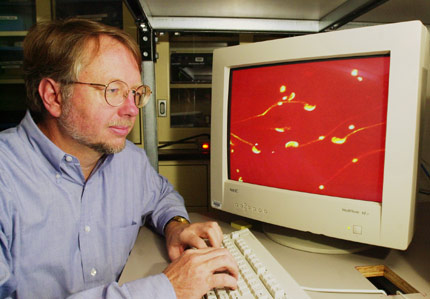Trigger is found for sperm mobility

Penetration is never easy for a sperm. Getting to an egg has been compared to a salmon swimming upstream to spawn. Both have to lash their tails vigorously to reach their goal. The sperm then has to bore through a protective coating before it can fuse itself with the egg and inject genes into it.
Many sperm never make it.
Researchers have now found one reason why – a protein without which their forceful swimming movements slow to an ineffective paddle. Normal sperm, which have this so-called CatSper protein, beat their tails energetically and show progressive movements. Those lacking it swim with greatly reduced speed and move more randomly.
Although they display normal mating behavior, mice without CatSper are 100 percent ineffective at impregnating females. No experiments have been conducted yet with humans for obvious reasons, but we have a gene responsible for making a similar protein.
“I expect that what’s true in mice is true in humans,” says David Clapham, a professor of neurobiology and of pediatrics at the Harvard Medical School who led the research. “Their genomes are very similar to ours.”
The discovery opens up the possibility of new screening methods for infertility and a birth-control pill for both men and women.
Lack of the CatSper protein might make men as infertile as the mice. Taking a drug to temporarily block the protein could prevent conception.
“If it was quick acting, a CatSper drug could also be used by women,” Clapham notes. “It could get from her bloodstream to fluids in the vagina and uterus in time to block the progress of sperm. Preferably, such a drug would be taken before sex. However, it might also block fertilization after sex. Many times sperm hang around in the oviduct for hours, waiting for eggs to be released.”
A CatSper blocker would have fewer undesirable side effects than birth control pills now taken by women because the protein is present only in sperm. Existing pills for women, and many of those under development for men, contain hormones that affect cells in almost every part of the body.
A patent has been applied for by Children’s Hospital, the Harvard-affiliated facility where this research was done. The hospital is negotiating a license with Hydra Biosciences of Boston to produce a drug to block the sperm-spurring protein.
Opening the gate
Discovery of the CatSper protein was serendipitous in the sense that Clapham’s team wasn’t looking for it. The group studies ion channels – proteins that open and close pores to let various substances into and out of a cell. “Roughly a third of all drugs target ion channels,” Clapham explains. Calcium channel blockers, for example, lower blood pressure; other such drugs treat heart arrhythmias, diabetes, and pain.
About two years ago, Clapham’s lab discovered an ion channel protein for which no use could be found. “It was frustrating,” Clapham admits. “We searched 50 different types of cells, including heart, brain, lung, and kidney cells from humans and mice, to try to find where the protein does its work. Dejian Ren, a postdoctoral student, did most of the work, and through his persistence we finally found that it was located in the testis.”
The CatSper channel, or gate, sits in the middle of a sperm’s relatively long tail. When opened, it allows electrically charged calcium molecules, called cations, to flow from body fluids into the sperm. These cations cause fiberlike proteins to contract rapidly and produce powerful lashings of the tail.
Entrance and exit of calcium in this way causes all human and mouse muscles, including the heart, to contract and relax. The fibrous proteins inside sperm cells are not unlike these muscles.
Research assistants Betsy Navarro and Alexander Jackson worked long and hard to measure tiny electric currents generated by cations of calcium moving into the sperm. The task is so difficult because sperm tails are a hundred times thinner than a human hair and in constant motion.
The researchers then compared the sexual activity of normal male mice and those genetically engineered to lack the CatSper gene. Both groups exhibited the same sexual behavior, mounting normal females the same number of times. However, none of the females sharing cages with the engineered mice became pregnant.
The incompetent sperm were then shipped to a fertility clinic at Massachusetts General Hospital in Boston, which has equipment to measure sperm mobility. Researchers there found that they move with one-third the speed of sperm from normal mice, and they travel with less deliberate orientation toward eggs.
These sluggish, disoriented movements prevented them from reaching their goal.
Too pooped to penetrate
As a sperm approaches an egg, it releases chemicals that dissolve the protective covering around the egg, known as the zona pellucida. The sperm then must burrow through the partially dissolved covering and fuse its head with the egg. Even when sperm that lack CatSper are placed on the egg covering by researchers, they are not mobile enough to tunnel into contact with the egg.
Clapham and his crew are now looking for other proteins that act in concert with CatSper. “Few proteins act alone,” Clapham notes. “We want to determine exactly what’s involved in opening and closing the ion gate.”
CatSper belongs to a large family of proteins whose function is to operate ion channels in many parts of the body, including the heart and brain. “We recently found a new one that’s present in humans and mice,” Clapham says. “We don’t know what it does yet, but such CatSper relatives might provide targets for drugs that treat problems in other organs. This opens up a whole new area of possibilities to pursue.”
Clapham cautions that people who read reports about his calcium channel research should not take them too literally. A woman in England telephoned him to ask if taking calcium pills would help her son-in-law with his fertility problem.




